Loss
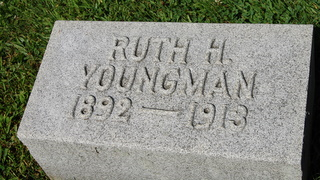 The headline read “Wedding Gown To Be Her Shroud.” The newspaper article was about a horrible tragedy, that took place just four days after the wedding of my husband, Bob’s 6th cousin 3 times removed, Ruth Schulenberg to Wilberd Youngman. The wedding took place on November 26, 1913, and was a large social affair for the smaller town of Tolono, Illinois, population of about 700, at the time. Ruth Schulenberg, was the daughter of Mr and Mrs Henry Schulenberg, and was a graduate of Saint Mary’s of the Wood where she was a member of a prominent sorority. Wilberd Youngman employed as a draughsman by the Burr Company of Champaign, Illinois. The wedding took place at Saint Patrick’s Catholic Church in Tolono.
The headline read “Wedding Gown To Be Her Shroud.” The newspaper article was about a horrible tragedy, that took place just four days after the wedding of my husband, Bob’s 6th cousin 3 times removed, Ruth Schulenberg to Wilberd Youngman. The wedding took place on November 26, 1913, and was a large social affair for the smaller town of Tolono, Illinois, population of about 700, at the time. Ruth Schulenberg, was the daughter of Mr and Mrs Henry Schulenberg, and was a graduate of Saint Mary’s of the Wood where she was a member of a prominent sorority. Wilberd Youngman employed as a draughsman by the Burr Company of Champaign, Illinois. The wedding took place at Saint Patrick’s Catholic Church in Tolono.
After their wedding, the young couple was on their honeymoon, in Kokomo, Indiana, where they had attended church at the Kokomo Catholic Church. Following the church service, they were on their way to a big wedding dinner in their honor at the country residence of a neighbor of Youngman’s cousin, Edward Grishaw, who was 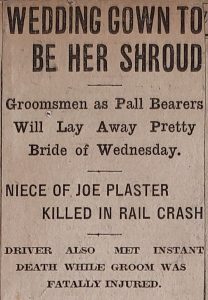
 transporting the couple in a closed carriage. As the carriage began its crossing of the tracks of the Lake Erie and Western Railway, Grishaw failed for look for trains, and pulled out in front of the Lake Erie train going full speed. The train ripped through the car, and by the time the train could stop and the crew reached the car’s occupants, Ruth Schulenberg and Edward Grishaw were dead. Wilberd Youngman was critically injured, and not expected to live.
transporting the couple in a closed carriage. As the carriage began its crossing of the tracks of the Lake Erie and Western Railway, Grishaw failed for look for trains, and pulled out in front of the Lake Erie train going full speed. The train ripped through the car, and by the time the train could stop and the crew reached the car’s occupants, Ruth Schulenberg and Edward Grishaw were dead. Wilberd Youngman was critically injured, and not expected to live.
Amazingly, Wilberd Youngman did live…for eleven months. Youngman was taken to a hospital in Chicago, but his prognosis was grim. People just don’t come back from being hit by a train that ripped their car apart, and yet he was still alive, and actually recovering from his injuries…the visible injuries anyway. Youngman had lost so much that November day, and he was struggling to move forward. Ruth Schulenberg had been his soulmate, and his very best friend. She was the love of his life, and he knew there could never be another woman for him. Wilberd Youngman was not a man who would commit suicide, but he also could not recover from this deepest injury…the one that broke his heart. Slowly, over the eleven months that followed the saddest day of 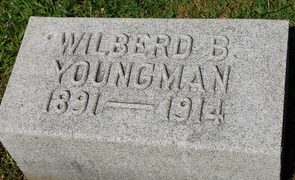 his life, Wilberd Youngman dwindled away. it wasn’t a refusal of food and water, but rather a refusal to go on without his precious Ruth. Finally, on October 24, 1914, just short of 11 months after that awful day…November 30, 1913, Wilberd Youngman could no longer go on living, and so, with his parents by his side, he simply passed away. The final cause of death was listed as a broken heart. That, to me was the saddest cause of death I had ever heard. Because of the loss of his wife, Wilberd simply had no desire to live either. He tried to recover…physically, but his heart was no longer in it, and he finally just gave up and quit trying. The Honeymoon Tragedy had finally claimed it’s last victim.
his life, Wilberd Youngman dwindled away. it wasn’t a refusal of food and water, but rather a refusal to go on without his precious Ruth. Finally, on October 24, 1914, just short of 11 months after that awful day…November 30, 1913, Wilberd Youngman could no longer go on living, and so, with his parents by his side, he simply passed away. The final cause of death was listed as a broken heart. That, to me was the saddest cause of death I had ever heard. Because of the loss of his wife, Wilberd simply had no desire to live either. He tried to recover…physically, but his heart was no longer in it, and he finally just gave up and quit trying. The Honeymoon Tragedy had finally claimed it’s last victim.
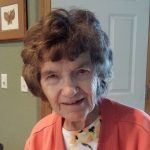
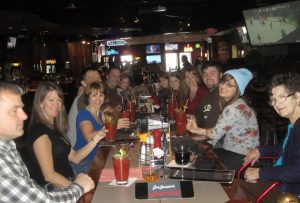 Four years ago, my mom, Collene Spencer; my sister, Cheryl Masterson; and I took a trip back to Superior, Wisconsin, which is where Cheryl and I were born. While we were there, we were invited to Julie Carlson Soukup’s home for dinner. My mom knew the parents of these cousins who had welcomed us into their home. Cheryl and I did too, but it had been a number of years since we had seen them, and certainly, most of the cousins themselves were totally new to us. We watched as the Carlson kids brought their mother, Carol Carlson to the dinner. She had been dealing with Lewy Body Dementia, which is much like Alzheimer’s disease, but with the added issue of motor problems. These kids were so careful with her, and so determined that she be able to come for this visit. It brought tears to my eyes to see such love. Having been a caregiver for a long time, I knew how much work caregiving is, but they didn’t care what it took. She was their mom.
Four years ago, my mom, Collene Spencer; my sister, Cheryl Masterson; and I took a trip back to Superior, Wisconsin, which is where Cheryl and I were born. While we were there, we were invited to Julie Carlson Soukup’s home for dinner. My mom knew the parents of these cousins who had welcomed us into their home. Cheryl and I did too, but it had been a number of years since we had seen them, and certainly, most of the cousins themselves were totally new to us. We watched as the Carlson kids brought their mother, Carol Carlson to the dinner. She had been dealing with Lewy Body Dementia, which is much like Alzheimer’s disease, but with the added issue of motor problems. These kids were so careful with her, and so determined that she be able to come for this visit. It brought tears to my eyes to see such love. Having been a caregiver for a long time, I knew how much work caregiving is, but they didn’t care what it took. She was their mom.
I didn’t know Carol well, but over the years, I watched as the Carlson family centered life around her. They took her so many places, and everywhere they went was an event, documented with lots of pictures. They were, of course, building their memories, knowing that the future was uncertain. They didn’t want to think about the day when Carol would no longer be with them. Right before we came for that visit, they had just had to move Carol into an nursing home, because she could no longer live on her own. Once again they showed her the greatest love they could have for her. They told her about her life, the life that had begun to slip away from her memory files. They needed to preserve it for her somehow.
When Carol passed away, on August 2nd, 2018, I began to recall the many beautiful things the Carlson family had done for her, but I realized that I didn’t really know much about her life. I wanted her children to share some of their favorite memories with me, because I knew that I wanted to write a tribute to their beautiful mother. They decided that they would send me a copy of the letter written by her oldest daughter, Laurie Carlson Stepp at the time they moved Carol into the nursing home. The children put together a scrap book filled with letters from her children and grandchildren, poems she had written, stories about her, such as her sayings…things they had heard her say all their lives, and pictures for her to see. It was their gift to their mother…her memories. They were giving them back to her.
I could never begin to write her memories with the beauty that her children and grandchildren did. Their 
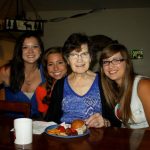 memories of her were their gift of love to her, and that is beyond special. Nevertheless, I want to try to highlight some of the wonderful things Carol Schumacher Carlson did in her lifetime. The reality is that Carol almost didn’t exist. Laurie tells that story in her letter to her mom, “Your parents, Fred and Anna Schumacher already had one lovely daughter, Beatrice. When she was born, there were serious difficulties and the doctor told Fred that he would have to choose between his wife and the baby. He chose his wife……she chose the baby! They were both saved, but the doctor cautioned against having any more children. So that is why you Carol were a miracle baby.” The faith of her parents brought about Carol’s life, as well as nine siblings after her. The letter told of the help Carol gave her mom with her younger siblings, Leslie, Carl, Margaret, Gilbert, Delwin, Noreen, Bernice, Bob, and Dale.
memories of her were their gift of love to her, and that is beyond special. Nevertheless, I want to try to highlight some of the wonderful things Carol Schumacher Carlson did in her lifetime. The reality is that Carol almost didn’t exist. Laurie tells that story in her letter to her mom, “Your parents, Fred and Anna Schumacher already had one lovely daughter, Beatrice. When she was born, there were serious difficulties and the doctor told Fred that he would have to choose between his wife and the baby. He chose his wife……she chose the baby! They were both saved, but the doctor cautioned against having any more children. So that is why you Carol were a miracle baby.” The faith of her parents brought about Carol’s life, as well as nine siblings after her. The letter told of the help Carol gave her mom with her younger siblings, Leslie, Carl, Margaret, Gilbert, Delwin, Noreen, Bernice, Bob, and Dale.
Carol was a hard worker all her life. She worked at Hills Brothers Dairy, then for a lawyer in Billings Park babysitting their children, as a waitress at the Princess Sweet Shop, at Phoenix Hosiery, at Twin Ports Dairy…where she did office work, and at Kempenski Glass Company. All these were jobs, but her real life’s work was to be the mother of her children. Carol married Donald John Carlson on August 21, 1954, and they would be blessed with Donny, Laurie, Steve, Dave, Jim and twins – Julie and Jeanne. Carol also had bonus children, Bonnie and Randy, from Don’s first marriage. Carol was a housewife, and very good at her job. They grew a big garden, canned and froze enough food to keep the family in vegetables most of the year. Their dad would come home and there was always a flurry of activity and fun. Carol cooked, cleaned, sewed, and took care of her family, and still had time to help out others too. The children always came home from school to some kind of homemade snack, but more importantly…they came home to their mom, Carol, who welcomed them with open arms. Carol baked 5 loaves of bread every day and packed countless lunches. She sewed clothes for her family and often surprised them with something new that they needed after staying up all night working with her sewing machine until it was finished. She made clothes, quilts, tents, and just about anything that could be made with cloth for her family and for her grandchildren too. She made Indian costumes with real tepees, which have been used by most of her grandsons. She made a pair of sandals for Jon and Josh when they were starting to walk, Prom dresses, bridesmaid dresses, suits, pants, skirts, shirts, blouses…the family was always wearing something Carol had made. They have always felt so blessed to have Carol in their lives.
When I set out to write this tribute to Carol Schumacher Carlson, I wanted it to be about the amazing things 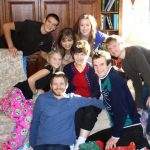
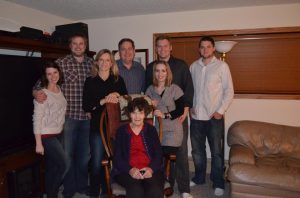 she did for those she loved. Little did I know that it would be about the amazing children she raised, but in reality, it had to be about her amazing children, because that was what Carol was all about. Her whole life was spent giving of herself to those she loved and cared about. It was Carol, who along with her husband, Don raised these kids to be the loving, responsible adults that they have become. That, in itself, is a tribute to Carol. Her hard work for her family, was her gift to them, and they were her reward…her legacy.
she did for those she loved. Little did I know that it would be about the amazing children she raised, but in reality, it had to be about her amazing children, because that was what Carol was all about. Her whole life was spent giving of herself to those she loved and cared about. It was Carol, who along with her husband, Don raised these kids to be the loving, responsible adults that they have become. That, in itself, is a tribute to Carol. Her hard work for her family, was her gift to them, and they were her reward…her legacy.
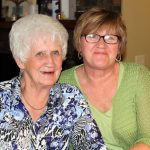 When I was a little girl, my family lived in Superior, Wisconsin. Those were wonderful years, but in more recent years we had not been back to Superior for a number of years. When my mom, Collene Spencer wanted to go back to Superior, my sister, Cheryl Masterson and I took her, since our dad had passed away by then. That, Ancestry, and Facebook opened up a whole new world for Cheryl and me. We got to know our cousins, and the list of cousins we know grows every day…or at least every year. This year, with the Schumacher Family Reunion, we knew we had to go, even though it would be without Mom this time. This trip was bittersweet, because of course, Mom was missing.
When I was a little girl, my family lived in Superior, Wisconsin. Those were wonderful years, but in more recent years we had not been back to Superior for a number of years. When my mom, Collene Spencer wanted to go back to Superior, my sister, Cheryl Masterson and I took her, since our dad had passed away by then. That, Ancestry, and Facebook opened up a whole new world for Cheryl and me. We got to know our cousins, and the list of cousins we know grows every day…or at least every year. This year, with the Schumacher Family Reunion, we knew we had to go, even though it would be without Mom this time. This trip was bittersweet, because of course, Mom was missing.
Nevertheless, we have had a wonderful time. When we were here the last time, our first cousins once removed, Les and Bev Schumacher had wanted us to come to their house, but our time was do limited, that we didn’t have time to. This time, their daughter, Cathy La Porte graciously invited us for dinner this evening. We got to meet her husband, Gary, as well as to see her brother, Brian Schumacher and his wife, Lisa again. It was simply a wonderful evening. Cathy is an excellent cook and we were treated to Walleye Pike and Northern Pike that Cathy’s husband, Gary caught in North Dakota with his brother this past 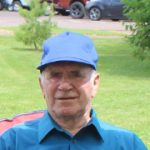 week. Wow!!! Was it good. Dessert was a Cherry Crumble that Lisa’s friend had given her, and everyone loved it.
week. Wow!!! Was it good. Dessert was a Cherry Crumble that Lisa’s friend had given her, and everyone loved it.
The evening was very enjoyable and will always be a sweet memory from our trip. The trip has gone by so fast, and what we thought was enough time, really wasn’t…it never is, is it? Nevertheless, the friendships (cousinships) formed will last for the rest of our lives, and while our parents weren’t there this time, we know they would be smiling…happy to see their daughters and granddaughter continue to reach out to the family as if they were with us. I guess we are carrying on the connections, and that would make them happy, and it makes me happy.
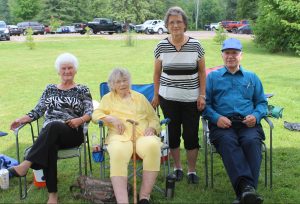
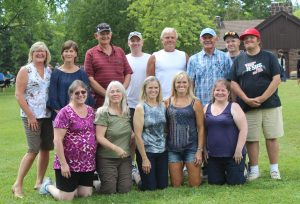 A few years back, I connected with a member of my Schumacher cousins, Tracey Schumacher Inglimo, in what would become a quest to get to know all of my Schumacher cousins, and like my Byer cousins, there were lots of them. The journey has been a wonderful trip, as my sisters and I have cultivated friendships with these precious cousins, some of whom we met on our 2014 trip back to our roots in Superior, Wisconsin. Now, four years later, my sister, Cheryl Masterson; her daughter, Liz Masterson; and I have returned to Superior, Wisconsin for a family reunion. We have been so excited for this reunion to happen, and in fact, have looked forward to reuniting with all of our cousins since we first met or found each other on Ancestry and Facebook.
A few years back, I connected with a member of my Schumacher cousins, Tracey Schumacher Inglimo, in what would become a quest to get to know all of my Schumacher cousins, and like my Byer cousins, there were lots of them. The journey has been a wonderful trip, as my sisters and I have cultivated friendships with these precious cousins, some of whom we met on our 2014 trip back to our roots in Superior, Wisconsin. Now, four years later, my sister, Cheryl Masterson; her daughter, Liz Masterson; and I have returned to Superior, Wisconsin for a family reunion. We have been so excited for this reunion to happen, and in fact, have looked forward to reuniting with all of our cousins since we first met or found each other on Ancestry and Facebook.
The reunion took place today at Pattison Park, and it definitely lived up to every hope we had for it. These precious cousins were friendly, hospitable, and informative, while also being curious about us too. We all shared tons of stories about our families, and of course, pictures of our kids, grandkids, and great grandkids. We hugged on the little ones, most of whom looked at us with a sense of wonder as to who we were, and maybe even wondering if we should be hugging them at all…at least until their parents said it was ok. We moved from group to group, and person to person trying to get to know everyone, all the while knowing that there just wasn’t enough time. We found out who the jokesters were too, because what family would be complete without those wonderful people who keep us laughing. We built bonds that will last a lifetime, and parted ways with expressions of sadness that the time had passed far to quickly. We tried to see how soon we could feasibly do this again, knowing that for most of us Facebook would have to suffice until the next reunion.
The time went by far too quickly indeed, and while we wish we could have had far more time to sit and talk, we all knew in our hearts that we had been given a precious gift…a gift of family, friendship, love, and a sense of belonging, because after all, that is what family reunions are all about. Families grow quickly, and the numbers can quickly grow to a point of losing sight of the ones who started the family in the beginning, but at reunions, 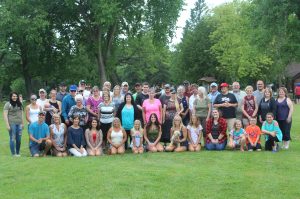
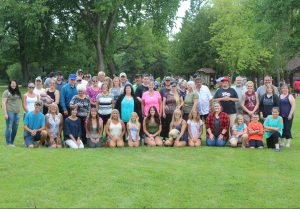 those who have left us are remembered and discussed, because everyone is trying to put into context, just exactly where they fit in with all these people. We talked of those who weren’t with us with love and sadness, because they would have really loved that their families have made the effort to keep the closeness going. To all those who made this reunion so very special, we love you and thank you for making our family reunion amazing.
those who have left us are remembered and discussed, because everyone is trying to put into context, just exactly where they fit in with all these people. We talked of those who weren’t with us with love and sadness, because they would have really loved that their families have made the effort to keep the closeness going. To all those who made this reunion so very special, we love you and thank you for making our family reunion amazing.
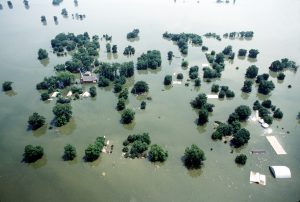 For many years, levee systems were built along rivers to hold back flood waters. They work very well…until they don’t. When a levee ruptures, the resulting flood is usually devastating. From June through August of 1993, the midwestern United States received an unusually large amount of rain…far more than normal. The rain led to severe flooding, particularly along the Illinois and Missouri shores. Then, on July 22, 1993, the levee holding back the flooding Mississippi River at Kaskaskia, Illinois, ruptured. The town’s people were forced to flee on barges. In all, more than 1,000 levees burst in late July, but, the incident at Kaskaskia was the most dramatic event of the flood. The town, which was virtually an island, was protected by a levee that the town attempted to shore up even after the bridge connecting the town to the riverside was wiped out by the rising river. At
For many years, levee systems were built along rivers to hold back flood waters. They work very well…until they don’t. When a levee ruptures, the resulting flood is usually devastating. From June through August of 1993, the midwestern United States received an unusually large amount of rain…far more than normal. The rain led to severe flooding, particularly along the Illinois and Missouri shores. Then, on July 22, 1993, the levee holding back the flooding Mississippi River at Kaskaskia, Illinois, ruptured. The town’s people were forced to flee on barges. In all, more than 1,000 levees burst in late July, but, the incident at Kaskaskia was the most dramatic event of the flood. The town, which was virtually an island, was protected by a levee that the town attempted to shore up even after the bridge connecting the town to the riverside was wiped out by the rising river. At  9:48am, the levee broke, leaving the people of Kaskaskia with no escape route other than two Army Corp of Engineers barges. By 2pm, the entire town was underwater.
9:48am, the levee broke, leaving the people of Kaskaskia with no escape route other than two Army Corp of Engineers barges. By 2pm, the entire town was underwater.
The rupture of the levee at Quincy, Illinois, left no way to cross the Mississippi River for 250 miles north of Saint Louis. In Grafton, Illinois, flood waters reached two stories high. Other towns fared somewhat better, but the flooding was bad everywhere. In Saint Genevieve, Missouri, the entire town turned out in a desperate attempt to raise the levee. Prisoners were even brought in to assist the effort. The river crested at a record 49 feet, just two feet below the improved levee. The flood inundated 1 million acres of prime farm land and wreaked havoc on the area’s economy. Miles of wheat fields were too saturated to harvest that season. In addition, the herbicides from the farms washed down the river and severely damaged fish farms in Louisiana. Many other people lost their jobs when barge traffic on the river was suspended for two months. The Mississippi 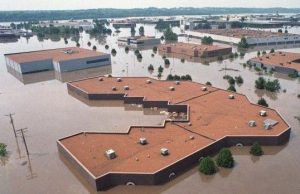 flood of 1993 caused $18 billion in damages and killed 52 people.
flood of 1993 caused $18 billion in damages and killed 52 people.
Levees can save lives, but when levees fail…people die, and property is destroyed. Sometimes, there is some warning, but other times, the flood that was expected, brings with it an unexpected consequence. And I can’t think of a worse unexpected consequence, than having far more water inundate an area that the flood could possibly have brought in. That was the case in 1993, and especially the case in Kaskaskia, Illinois. No one was prepared for the massive amount of water, and for 52 people, there was no way of escape.
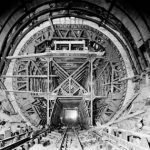 Most safety measures have come from disasters caused by a lack of safety measures. The Hawk’s Nest Tunnel disaster was no different. But sometimes, the safety measures were known and readily available, but were not used, often to save time or money, and always in blatant disregard for the lives of the workers. On March 30, 1930, construction began on the Hawk’s Nest Tunnel. The tunnel was supposed to be a good thing, and in the end, it was, but the necessary measures were not used to keep the workers safe, and the time they spent in the tunnel turned out to be deadly.
Most safety measures have come from disasters caused by a lack of safety measures. The Hawk’s Nest Tunnel disaster was no different. But sometimes, the safety measures were known and readily available, but were not used, often to save time or money, and always in blatant disregard for the lives of the workers. On March 30, 1930, construction began on the Hawk’s Nest Tunnel. The tunnel was supposed to be a good thing, and in the end, it was, but the necessary measures were not used to keep the workers safe, and the time they spent in the tunnel turned out to be deadly.
This tunnel would be used to divert much of the flow of the New River from the Hawk’s Nest Dam under Gauley Mountain, located about 3 miles away, to a hydro-electric plant at the other end. As construction proceeded, it was discovered that the rock they were cutting had a high silica content. Silica was used in steel making. It seemed like a win-win situation, but  not for the 3,000 mostly African-American migrant workers from the south. Rhinehart and Dennis, a company from Charlottesville, Virginia, was awarded the contract. While the management, who visited the tunnel periodically, wore masks and breathing equipment, the workers were not given such equipment. Drilling should have been done using water, but it was not. They were trying to save time and money. The workers were exposed to the silica dust and developed a lung disease called silicosis, for which there is no cure.
not for the 3,000 mostly African-American migrant workers from the south. Rhinehart and Dennis, a company from Charlottesville, Virginia, was awarded the contract. While the management, who visited the tunnel periodically, wore masks and breathing equipment, the workers were not given such equipment. Drilling should have been done using water, but it was not. They were trying to save time and money. The workers were exposed to the silica dust and developed a lung disease called silicosis, for which there is no cure.
This deliberate disregard for safety caused some of the workers to become sick and die from silicosis within a year. There were only 109 admitted deaths, but a Congressional hearing conducted later determined that there were actually 476 deaths attributed to the project. Since that time, some sources have said the number could actually be as high as 700 to 1,000 deaths. This takes into account the workers that could have had minimal  exposure to the silica but were affected by it later in life.
exposure to the silica but were affected by it later in life.
The Hawk’s Nest Tunnel is still in use today, diverting water from the New River to produce hydro-electricity for the Alloy plant. Silicosis has been designated an occupational disease. Now compensation for workers affected by it is available. Unfortunately, the tunnel workers at Hawk’s Nest were not protected by these laws. This project is considered to be one of the worst industrial disasters in American history. The tunnel did its job, and continues to do so. I just wish it hadn’t cost so many lives to make the tunnel. It should not have had to come at such a great price.
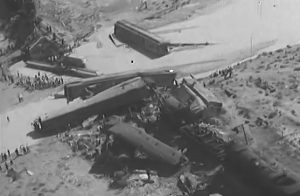 A sudden downpour near Terry, Montana on the evening of June 19, 1938 caused a flash flooding of the Custer Creek that would lead to a disaster before the night was over. Earlier in the day, a track walker was sent out the check the rail lines near Custer Creek which was located near the town of Terry, Montana. After his inspection, he reported to his superiors that the conditions were dry, and there were no problems with the tracks.
A sudden downpour near Terry, Montana on the evening of June 19, 1938 caused a flash flooding of the Custer Creek that would lead to a disaster before the night was over. Earlier in the day, a track walker was sent out the check the rail lines near Custer Creek which was located near the town of Terry, Montana. After his inspection, he reported to his superiors that the conditions were dry, and there were no problems with the tracks.
That was true at the time, but within a few hours, a sudden downpour overwhelmed Custer Creek. A small winding river, Custer Creek runs through 25 miles of the Great Plains before depositing into the Yellowstone River. Small streams like Custer Creek are prone to flash floods, because they don’t have  the capacity to handle any big influx of water, and their banks can quickly and easily be overtaken during heavy rains. As the water came rushing down stream, it washed out a bridge used by the trains. When the Olympian Special came through, it went crashing into the raging waters with no warning. Two sleeper cars were buried in the muddy waters. The night was pitch black seriously hampering rescue efforts. In all, 46 people lost their lives, and 60 others were seriously injured. The rear cars stayed above the water, but scores of passengers were seriously injured. They could not be evacuated until the following morning. I can’t even begin to imagine how awful that was.
the capacity to handle any big influx of water, and their banks can quickly and easily be overtaken during heavy rains. As the water came rushing down stream, it washed out a bridge used by the trains. When the Olympian Special came through, it went crashing into the raging waters with no warning. Two sleeper cars were buried in the muddy waters. The night was pitch black seriously hampering rescue efforts. In all, 46 people lost their lives, and 60 others were seriously injured. The rear cars stayed above the water, but scores of passengers were seriously injured. They could not be evacuated until the following morning. I can’t even begin to imagine how awful that was.
That was a tough week for Montana. Just a few days later, Black Eagle saw “torrents of water” that floated 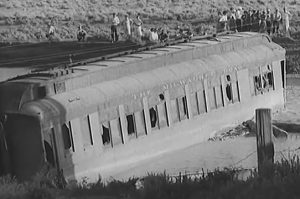 furniture in the house of Sam Tadich, the sheriff had to help a rescue effort, the road to Giant Springs washed away and water was up to cows’ flanks around the Sun River. Havre’s worst flood came in June 22, 1938, when a cloudburst in the Bear Paw Mountains sent out a wall of water. Ten people were killed. Floating train cars were wedged under the viaduct, 10 miles of highway were underwater between Laredo and Box Elder, with a bridge washed out, the Havre Daily News reported. Rain is a good thing, but too much rain, coming too fast can devastate an area, especially one with a creek or river, in a very short time, and for Montana, it was a very rainy week, making it a very tough week.
furniture in the house of Sam Tadich, the sheriff had to help a rescue effort, the road to Giant Springs washed away and water was up to cows’ flanks around the Sun River. Havre’s worst flood came in June 22, 1938, when a cloudburst in the Bear Paw Mountains sent out a wall of water. Ten people were killed. Floating train cars were wedged under the viaduct, 10 miles of highway were underwater between Laredo and Box Elder, with a bridge washed out, the Havre Daily News reported. Rain is a good thing, but too much rain, coming too fast can devastate an area, especially one with a creek or river, in a very short time, and for Montana, it was a very rainy week, making it a very tough week.
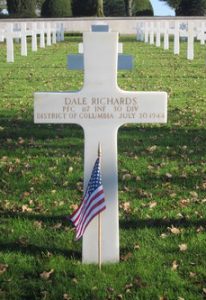 Memorial Day…an often misunderstood day, is actually a day to remember those military men and women who paid the ultimate price for our freedom…they gave their life in service to their country. Whether we know it or not, I’m sure that every family has lost a love one to war…some war in history. It might be many years in the past, and we may not even know about it at all, nevertheless, it is our duty to remember and to honor them, because they sacrificed their very lives that we might live in a free nation. It is so hard to think of someone that we care about, being killed in a foreign country while fighting a war.
Memorial Day…an often misunderstood day, is actually a day to remember those military men and women who paid the ultimate price for our freedom…they gave their life in service to their country. Whether we know it or not, I’m sure that every family has lost a love one to war…some war in history. It might be many years in the past, and we may not even know about it at all, nevertheless, it is our duty to remember and to honor them, because they sacrificed their very lives that we might live in a free nation. It is so hard to think of someone that we care about, being killed in a foreign country while fighting a war.
I am one of those people who doesn’t personally know of a family member lost in a war, but my Uncle Jim Richards brother, Dale was lost on the beaches of Normandy France on July 30, 1944. It is incomprehensible to me to think of his family getting word of his passing, only to find out that they would have to foot the bill to bring him home for burial. There simply were not enough funds, and so Dale was buried at the Brittany American Cemetery and Memorial, in Normandy, France. I can’t begin to imagine the awful day when the summer suddenly seemed as cold as ice. No parent should have to outlive their child, but with war comes death, and someone’s son or daughter will not be coming home again. I heard it put best in a song by Tim McGraw. The song, If you’re Reading This talks about getting a “one way ticket” over there. Unfortunately, far too many of our young men and women have been given that one way ticket, and while they paid with their lives, their families paid too. Their loved one is forever take from them, and they are left to mourn…to try to go on with their lives.
So many people look at Memorial Day as a holiday…a day to hold picnics, sports events and family gatherings. This day is traditionally seen as the start of the summer season for cultural events. For the fashion conscious, it is seen as acceptable to wear white clothing, particularly shoes from Memorial Day until Labor Day. However, fewer and fewer people follow this rule and many wear white clothing throughout the year. But how should we, the living, best honor the lives of all those who have died in service to our country? On Memorial Day, it is traditional to fly the flag of the United States at half staff from dawn until noon. Many people visit cemeteries 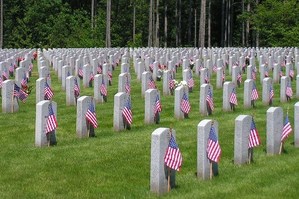 and memorials, particularly to honor those who have died in military service. Many volunteers place an American flag on each grave in national cemeteries. in reality, this is a day to reflect on the sacrifices made to keep us free. While we feel like we should be honoring veterans who have passed away, the reality is that their day is Veterans Day, which honors the veterans of all wars living or dead. Within the military, there is a very strict protocol concerning the days we honor military personnel. The other thing that we tend to find odd about Memorial Day, is that we can’t go to someone and thank them for their sacrifice, because the way they came to be honored is to have given their life for their country. All we can do is to honor their memory.
and memorials, particularly to honor those who have died in military service. Many volunteers place an American flag on each grave in national cemeteries. in reality, this is a day to reflect on the sacrifices made to keep us free. While we feel like we should be honoring veterans who have passed away, the reality is that their day is Veterans Day, which honors the veterans of all wars living or dead. Within the military, there is a very strict protocol concerning the days we honor military personnel. The other thing that we tend to find odd about Memorial Day, is that we can’t go to someone and thank them for their sacrifice, because the way they came to be honored is to have given their life for their country. All we can do is to honor their memory.
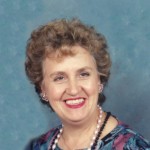 In church today, our pastor talked about how moms can become invisible to their children. Of course, he was talking about how we can take them for granted, but there is another way that our mom can become invisible…at least to us here. When your mom goes to Heaven and you can no longer see her, or talk to her. While she is no longer with us here on earth, that doesn’t mean her love for us ends. Love will endure forever. She was the one who carried us in her womb for nine months, and then brought us into this world. She nurtured us through life, and helped us to become independent people, who can take charge of our own lives.
In church today, our pastor talked about how moms can become invisible to their children. Of course, he was talking about how we can take them for granted, but there is another way that our mom can become invisible…at least to us here. When your mom goes to Heaven and you can no longer see her, or talk to her. While she is no longer with us here on earth, that doesn’t mean her love for us ends. Love will endure forever. She was the one who carried us in her womb for nine months, and then brought us into this world. She nurtured us through life, and helped us to become independent people, who can take charge of our own lives.
I’m sure there were many times when we took her for granted, and didn’t give her the respect she deserved, but she always forgave us for our thoughtlessness. In her wisdom, she knew that we really didn’t mean it. Still, our words must have hurt…our actions must have stung. Nevertheless, Mom forgave and didn’t hold it against us. I’m sure some of them us were much more of a challenge than others, and I place myself in that category, because I think I had the ability to be a trial sometimes…and I think I might be putting that somewhat mildly. Still, that doesn’t mean that I did not care about my mom, but rather that her daughter was stubborn. Mom always forgave me anyway, and for that I consider myself blessed. Our moms taught us what it meant to be parents…the need to forgive our kids for the stupid things we did. We learned parenting from our parents after all, and much of the nurturing qualities come from our mothers. Where would our kids be without our mothers to show us how to be mothers. We learned it from her.
Still, over those years, we have all taken our moms for granted. We didn’t really see them. They were a fixture in our lives. They performed a function, but we were seldom grateful. Then, when they are suddenly gone, we 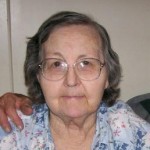 finally get it. We realize that they quietly took care of all the needs of our lives. They took a back seat so that we could shine. They cooked and cleaned, and received no thanks from us. We sassed them and disrespected them, and even though we may have said we were sorry, we could not take those things back. They were forever out there. Then, for some of us, the day came when they left this earth and we learned what it was like without that wonderful person that we had taken so much for granted…viewed as invisible…whether we realized it or not. For us, invisible took on a whole new meaning where our mother was concerned. I was blessed in this life to have a wonderful mom and mother-in-law, and both of them are invisible to me now. They are in Heaven, but they will never be forgotten. Happy Mother’s Day in Heaven to my two moms. I love and miss you both.
finally get it. We realize that they quietly took care of all the needs of our lives. They took a back seat so that we could shine. They cooked and cleaned, and received no thanks from us. We sassed them and disrespected them, and even though we may have said we were sorry, we could not take those things back. They were forever out there. Then, for some of us, the day came when they left this earth and we learned what it was like without that wonderful person that we had taken so much for granted…viewed as invisible…whether we realized it or not. For us, invisible took on a whole new meaning where our mother was concerned. I was blessed in this life to have a wonderful mom and mother-in-law, and both of them are invisible to me now. They are in Heaven, but they will never be forgotten. Happy Mother’s Day in Heaven to my two moms. I love and miss you both.
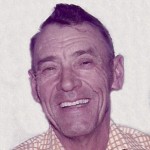 When I married into the Schulenberg family, I had no idea what the future would bring…we really never do. I just knew I was in love with my husband, Bob, and I liked his family very much too. Bob’s dad, Walt Schulenberg was quite a character, with a flair for teasing and joking with those people he liked. I liked him very much. In many ways, he was like my own dad, Al Spencer, and very much like my husband. They all loved to tease the “pretty girls,” as they would say, and it endeared them to every one of those girls too. Early on my father-in-law let me know what life in the Schulenberg family was going to be like. The first time I met him, he started teasing, and I sent much of the time red face, but not upset, because was used to it after all. My father-in-law was a happy man, and he liked to see the positive things in life. He had a great smile, and he wasn’t afraid to use it. Anyone who knew him, would tell you he was truly an amazing man.
When I married into the Schulenberg family, I had no idea what the future would bring…we really never do. I just knew I was in love with my husband, Bob, and I liked his family very much too. Bob’s dad, Walt Schulenberg was quite a character, with a flair for teasing and joking with those people he liked. I liked him very much. In many ways, he was like my own dad, Al Spencer, and very much like my husband. They all loved to tease the “pretty girls,” as they would say, and it endeared them to every one of those girls too. Early on my father-in-law let me know what life in the Schulenberg family was going to be like. The first time I met him, he started teasing, and I sent much of the time red face, but not upset, because was used to it after all. My father-in-law was a happy man, and he liked to see the positive things in life. He had a great smile, and he wasn’t afraid to use it. Anyone who knew him, would tell you he was truly an amazing man.

My father-in-law, who quickly became Dad, and the second great father figure in my life, was a hard working man…almost a workaholic, except that as important as his family was to him, he made sure to spend good quality time with all of us too. He loved my mother-in-law, Joann with all his heart, and his kids and grandkids a very close second. When his kids were young, he learned the value of spending time with family, when he was working out of town, and his daughter Brenda didn’t know him. That was it. He got a job closer to home. He loved being a grandpa and great grandpa, and I wish he could have been here to be a great great grandpa. He loved to make things for the kids, and they all loved the things he made.
He could make or build just about anything he put his mind to…from wooden toys and spinners, to a garage,  and even a house. He was a mechanic by trade (among other things), and he could fix just about anything. It was a trade he would pass to his sons and grandsons, and one that as served them all well. Having a mechanic in the family is always a good thing. I think Dad knew that would be important, and that’s why he taught his boys. There were so many things he taught them and his daughters and granddaughters. We never dreamed that one day he wouldn’t be there to teach us any more, but five years ago today, Dad left us to go to Heaven. We had hoped that day would never come. It was a very sad day for us then, and it still is sad today. I know that one day we will see him again, but it doesn’t make it any easier to face the beginning of another year without him in it. We love and miss you Dad…every day.
and even a house. He was a mechanic by trade (among other things), and he could fix just about anything. It was a trade he would pass to his sons and grandsons, and one that as served them all well. Having a mechanic in the family is always a good thing. I think Dad knew that would be important, and that’s why he taught his boys. There were so many things he taught them and his daughters and granddaughters. We never dreamed that one day he wouldn’t be there to teach us any more, but five years ago today, Dad left us to go to Heaven. We had hoped that day would never come. It was a very sad day for us then, and it still is sad today. I know that one day we will see him again, but it doesn’t make it any easier to face the beginning of another year without him in it. We love and miss you Dad…every day.

